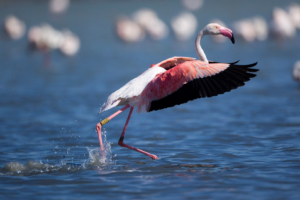Viruses and bacteria of wildlife form a vast world that is still largely unknown. The Tour du Valat teams are contributing to the understanding of this invisible part of biodiversity, which is a key element in the functioning of the ecosystems. Thus, two new species of bacteria from the family Chlamydiaceae have recently been discovered in flamingos. To learn more, read this article published this summer in the Systematic and Applied Microbiology journal.
You can access to it on the Tour du Valat web documentary portal.

Abstract:
The family Chlamydiaceae currently comprises a single genus Chlamydia, with 11 validly published species and seven more taxa. It includes the human pathogens Chlamydia (C.) trachomatis, C. pneumoniae and C. psittaci, a zoonotic agent causing avian chlamydiosis and human psittacosis, as well as other proven or potential pathogens in ruminants, birds, snakes, reptiles and turtles. During routine testing of 15 apparently healthy captive flamingos in a zoo in 2011, an atypical strain of Chlamydiaceae was detected by real-time PCR of cloacal swab samples. Sequence analysis of the 16S rRNA gene revealed high similarity to the uncultured Chlamydiales bacterium clone 122, which previously had been found in gulls. As more samples were collected during annual campaigns of the flamingo ringing program in southern France from 2012 to 2015, Chlamydiaceae-specific DNA was detected by PCR in 30.9% of wild birds. From these samples, three strains were successfully grown in cell culture. Ultrastructural analysis, comparison of 16S and 23S rRNA gene sequences, whole-genome analysis based on de novo hybrid-assembled sequences of the new strains as well as subsequent calculation of taxonomic parameters revealed that the relatedness of the flamingo isolates to established members of the family Chlamydiaceae was sufficiently distant to indicate that the three strains belong to two distinct species within a new genus. Based on these data, we propose the introduction of Chlamydiifrater gen. nov., as a new genus, and Chlamydiifrater phoenicopteri sp. nov. and Chlamydiifrater volucris sp. nov., as two new species of the genus.
Bibliographical reference: F. Vorimore, M. Hölzer, E.M. Liebler-Tenorio, L.-M. Barf, S. Delannoy, M. Vittecoq, R. Wedlarski, A. Lécu, S. Scharf, Y. Blanchard, P. Fach, R.C. Hsia, P.M. Bavoil, R. Rosselló-Móra, K. Laroucau, K. Sachse, Evidence for the existence of a new genus Chlamydiifrater gen. nov. inside the family Chlamydiaceae with two new species isolated from flamingo (Phoenicopterus roseus): Chlamydiifrater phoenicopteri sp. nov. and Chlamydiifrater volucris sp. nov., Systematic and Applied Microbiology, Volume 44, Issue 4, 2021, 126200, ISSN 0723-2020, https://doi.org/10.1016/j.syapm.2021.126200


